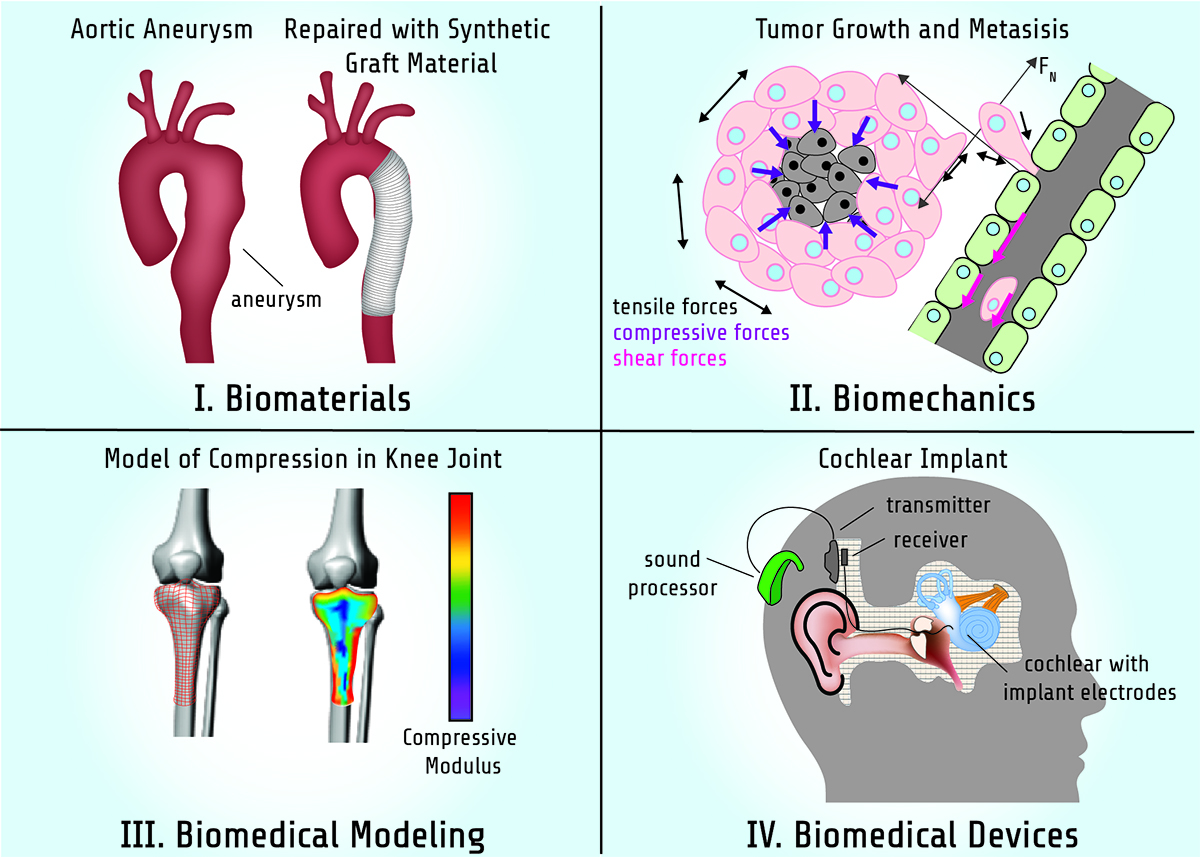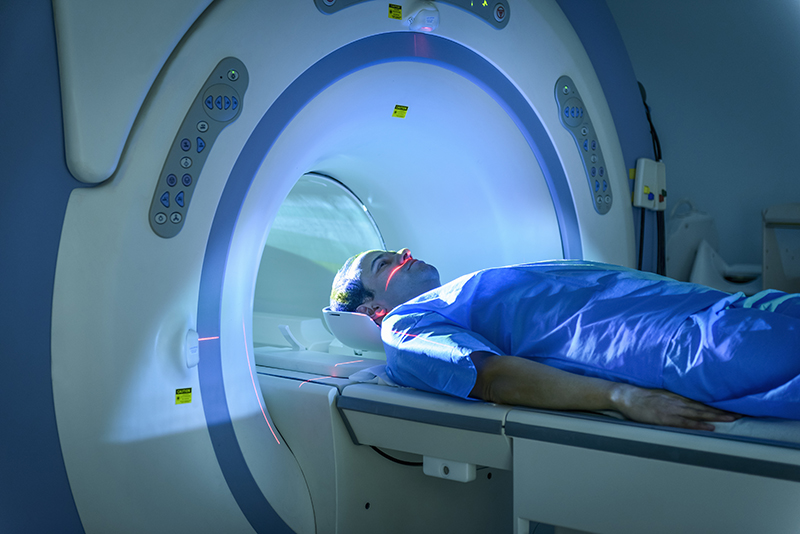Key Concepts
The application of principles from applied and physical sciences to problems in healthcare and biology. As a field, biomedical engineering draws from a variety of disciplines including mechanical, chemical, electrical, and computer engineering, as well as chemistry, biology, mathematics, computer science, materials science, robotics, and physics. The purpose of biomedical engineering is to better understand, mimic, support, or correct parts of the human body for the advancement of healthcare (Fig. 1). See also: Biology; Engineering

Biomedical engineers often work as part of a team with scientists and clinicians. The team progresses using an iterative process, identifying problems, proposing solutions, and testing them. This approach allows the team to optimize the solution and identify new knowledge. The role of the engineer in these teams is to convert new knowledge into a useful form. Biomedical engineers use basic scientific discoveries to invent new products, devices, and methods that improve human health.
Effects on daily life and medical intervention
Significant advancements in modern medicine have emerged from the work of biomedical engineers. The design of prosthetics is an illustrative example. Prosthetics are devices built to replace or support damaged mechanical parts of the body. Prosthetic devices hundreds of years ago existed primitively in the form of hooks and wooden peglegs. These prosthetics were designed with the knowledge available at the time and to fulfill the most basic function of the limb (stability), without interacting with the rest of the body or mind. A better understanding of human movement, together with developments in mechanical and material engineering, has since led to the creation of prosthetic limbs that support running, dancing, and jumping by mimicking a natural limb's mobility and function. Other modern prosthetics, such as cochlear implants, leverage our understanding of the physics of sound, electrical engineering, and physiology of the ear; these devices can stimulate the auditory nerve directly and provide a sense of sound to the deaf. Similarly, with a stronger understanding of cell physiology and materials science, biomedical engineers can create synthetic skin and bone grafts that provide physical support while enabling the regrowth of damaged tissue. See also: Hearing impairment; Prosthesis
Engineering solutions to advance human healthcare are not focused exclusively inside the body and include devices placed on and in the environment of the body. Everyday contributions from biomedical engineers in this regard include contact lenses, health and fitness smart watches, long-acting allergy medications, ankle braces for jogging, and implantable glucose sensors. Each of these examples began with new knowledge about the human body and then became a practical device through the work of engineers. See also: Allergy; Biosensor; Eyeglasses and contact lenses
The examples presented here demonstrate the vast collection of disciplines that come together to drive biomedical innovations. Some areas of study are essential for all biomedical engineering applications, such as quantitative human physiology and mathematical analysis. Other concepts, though, such as electrical signal processing, mechanics, or chemistry, are tools that are specific to particular subsets of biomedical engineering.
Biomaterials
Biomedical engineers rely on concepts from material science and chemical engineering to develop materials that best suit a particular healthcare need. Starting from natural materials or human-made substances—including polymers, metals, and ceramics—biomaterials are designed for a variety of uses. Contact lenses, resorbable sutures, and synthetic fiber grafts to replace damaged blood vessels are examples of biomaterials developed to match specific physical constraints. Biomaterials also have many applications in drug delivery and tissue engineering. Materials with specific chemical and physical compositions can be formulated into patches, particles, gels, or implants that control the transport of drugs in the body or support cell and tissue growth. See also: Ceramic; Metal; Polymer
Molecular, cellular, and tissue physiology
Biomedical engineers specializing in molecular, cellular, and tissue physiology seek to understand and modulate molecular pathways and functional processes either inside cells or between cells or tissues. This can be for the purpose of supporting regrowth, stimulating a biological function or inhibiting a detrimental behavior from those cells and tissues. Depending on the problem, approaches might involve the delivery of molecules, a change to the physical environment, or the introduction of new cells. For example, biomedical engineers may study molecules to make cancer cells more susceptible to chemotherapy or may design materials that will support repair and restore signal propagation in damaged nerve cells. This branch of biomedical engineering is deeply rooted in cellular and systems physiology but can be aided with biomaterials and mathematical modeling to understand how manipulations will affect the natural biological processes. See also: Cancer; Cell; Chemotherapy and other antineoplastic drug treatments; Molecule; Neuron; Tissue
Biomechanics
Biomechanics is the study of movement and forces acting on or within the body for the purpose of understanding a physical change, adding support, or building a replacement. Just as the human body is organized in a hierarchical structure of cellular units that build to tissues, organs, and organ systems, movement and forces can be analyzed on different length scales. Understanding forces acting on an individual unit as small as the cell (how structural proteins inside cells allow them to move and change shape) can provide insights on how tumor cells migrate; or a consideration of the dynamics in a unit as large as a joint can lead to the design of mechanical replacements for hips or knees. See also: Biomechanics; Protein
Biomedical imaging and diagnostics
Perhaps no area of biomedical engineering has had a more significant effect than the invention of methods for looking inside the body. Technologies such as radiographic imaging, computerized tomography (CT), magnetic resonance imaging (MRI) (Fig. 2), positron-emission tomography (PET), and ultrasound imaging provide physicians with reliable and safe methods to examine a patient's internal tissues and structures noninvasively. Continuing advances in computing technology are adding extraordinary power and novel capabilities to all imaging modalities. Biomedical engineers have contributed to both the design and construction of new imaging machines as well as the analysis of image data that are acquired from human subjects. These advancements in biomedical imaging have contributed to many biological and medical discoveries by enabling the observation of processes and elements within the body that are otherwise inaccessible. See also: Computerized tomography; Magnetic resonance; Medical imaging

Physiological modeling
Mathematical models are constructed to understand and predict system behaviors. Through mathematics and computational modeling, complex biological phenomena such as fluid flow, molecular and cell movement, forces, and power expenditures can be described and analyzed. For example, models that predict blood flow through an irregularly shaped blood vessel or heart valve, or calculate the forces acting on regions of an arthritic knee joint, can provide insight that would be difficult to obtain from direct observations. Mathematical models that are compared to experimental data can confirm mechanisms of cell, tissue, and organ function in health and disease. See also: Arthritis; Blood; Fluid-flow principles; Force; Power
Biomedical instrumentation
Monitoring devices and instruments are essential to the practice of medicine. Electronic instruments to monitor patient physiology—such as electrocardiogram (ECG) machines and blood pressure monitors—or replace critical functions—such as cardiac pacemakers—apply the consistency and control of machinery to support patients. As electronics advance, microelectronics can expand the reach of instruments by creating smaller, implantable devices that can deliver drugs, monitor local tissue states, and transmit internal information back outside the body. See also: Cardiac electrophysiology
Artificial organs
Traditionally, “artificial organs” are devices that replace critical functions for patients whose organs cannot perform normally (though tissue-engineered organs are also referred to by this term, see below). Examples of traditional artificial organs include heart and lung machines, which maintain blood circulation and oxygenation during surgical procedures involving the heart. Another example is dialysis machines, or an artificial kidney, which filters a patient's blood when renal function is impaired. See also: Dialysis; Heart; Lung
Developing biomedical engineering applications
Biomedical engineering continues to generate new frontiers in healthcare. Some of the more active applications of these advancements in recent years include the following.
Genetic engineering
Genetic engineering seeks to make changes to an organism's genome in both permanent and transient ways. The goal of the changes may be to correct a disease-related inherited gene by adding, subtracting, or replacing a piece of the genome, or to make cells behave a certain way by controlling or supplementing the genes that are expressed. Many bioengineering tools for this purpose exist, such as the CRISPR/Cas9 system, and many more are under development to improve their safety and accuracy. The CRISPR/Cas9 system scans a cell's DNA using a guide RNA strand as a template to find a desired sequence, then the Cas9 enzyme cuts the DNA at the target site. New gene sequences can then be introduced at the cut site to create a permanent change to the cell's behavior. See also: CRISPR/Cas9 gene editing; DNA; Enzyme; Genetic engineering; RNA
Tissue engineering
Manufacturing techniques such as 3D printing are used to print biological and sometimes living material (3D bioprinting) in a highly controlled manner. This capability makes it possible to print an accurate rendering of a living organ, with appropriate organization and functional units. These capabilities, together with advances in the understanding of stem cells and how they can be programmed to turn into other tissue types, could eventually be used to replace a damaged organ, arm, or leg with a new, printed version created from the patient's own tissue. As noted earlier, these organs derived from tissue engineering are also often referred to as artificial organs. See also: 3D printing
Lab-on-a-chip
The term lab-on-a-chip refers to creating human biomimetic systems in miniature. Combining microfabrication techniques with biomaterials and tissue engineering, a biological process can be organized to perform in isolation. For example, a small-scale model of the placental barrier can be used in experiments to learn how the Zika virus can pass from mother to fetus. The scaled-down version of a physiological system allows experiments to be done faster, with less material, or with more control. These tools can be used for diagnostic devices, flow modeling, drug screening, and disease modeling. See also: Zika virus disease
Head injury in contact sports
Dangerous head injuries, such as concussions, after forceful contact in sports including football remain an area of active research. Advanced tools for imaging, force measurements, and mechanical modeling enable the design of better protective wear and helmets. These improvements include new and stronger materials, improved shape, and built-in force sensors, which allow for monitoring of trauma exposure in real time. See also: Concussion; Sport-related concussion
Drug delivery
The engineering of drug delivery systems is among the most important areas of biomedical engineering. Infusion systems, implants, microparticles, and nanomaterials are used to control drug distribution in the body and duration of action. Currently available delivery systems are used to treat cancer, diabetes, hypertension, and other diseases effectively and safely. See also: Diabetes; Drug delivery systems; Hypertension





